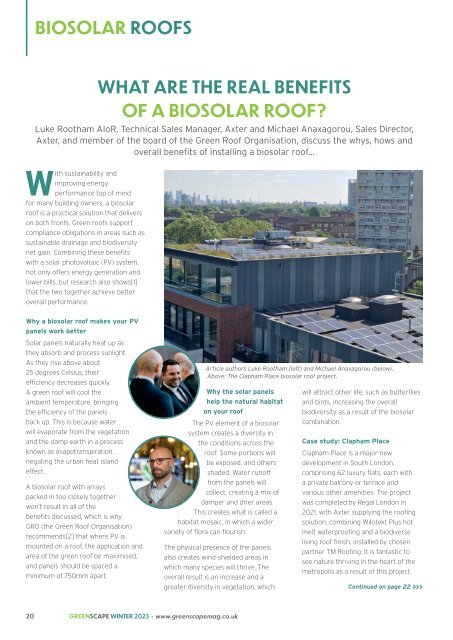Winter 2023
Create successful ePaper yourself
Turn your PDF publications into a flip-book with our unique Google optimized e-Paper software.
BIOSOLAR ROOFS<br />
WHAT ARE THE REAL BENEFITS<br />
OF A BIOSOLAR ROOF?<br />
Luke Rootham AIoR, Technical Sales Manager, Axter and Michael Anaxagorou, Sales Director,<br />
Axter, and member of the board of the Green Roof Organisation, discuss the whys, hows and<br />
overall benefits of installing a biosolar roof...<br />
With sustainability and<br />
improving energy<br />
performance top of mind<br />
for many building owners, a biosolar<br />
roof is a practical solution that delivers<br />
on both fronts. Green roofs support<br />
compliance obligations in areas such as<br />
sustainable drainage and biodiversity<br />
net gain. Combining these benefits<br />
with a solar photovoltaic (PV) system,<br />
not only offers energy generation and<br />
lower bills, but research also shows[1]<br />
that the two together achieve better<br />
overall performance.<br />
Why a biosolar roof makes your PV<br />
panels work better<br />
Solar panels naturally heat up as<br />
they absorb and process sunlight.<br />
As they rise above about<br />
25 degrees Celsius, their<br />
efficiency decreases quickly.<br />
A green roof will cool the<br />
ambient temperature, bringing<br />
the efficiency of the panels<br />
back up. This is because water<br />
will evaporate from the vegetation<br />
and the damp earth in a process<br />
known as evapotranspiration,<br />
negating the urban heat island<br />
effect.<br />
A biosolar roof with arrays<br />
packed in too closely together<br />
won’t result in all of the<br />
benefits discussed, which is why<br />
GRO (the Green Roof Organisation)<br />
recommends[2] that where PV is<br />
mounted on a roof, the application and<br />
area of the green roof be maximised,<br />
and panels should be spaced a<br />
minimum of 750mm apart.<br />
Article authors Luke Rootham (left) and Michael Anaxagorou (below).<br />
Above: The Clapham Place biosolar roof project.<br />
Why the solar panels<br />
help the natural habitat<br />
on your roof<br />
The PV element of a biosolar<br />
system creates a diversity in<br />
the conditions across the<br />
roof. Some portions will<br />
be exposed, and others<br />
shaded. Water runoff<br />
from the panels will<br />
collect, creating a mix of<br />
damper and drier areas.<br />
This creates what is called a<br />
habitat mosaic, in which a wider<br />
variety of flora can flourish.<br />
The physical presence of the panels<br />
also creates wind-shielded areas in<br />
which many species will thrive. The<br />
overall result is an increase and a<br />
greater diversity in vegetation, which<br />
will attract other life, such as butterflies<br />
and birds, increasing the overall<br />
biodiversity as a result of the biosolar<br />
combination.<br />
Case study: Clapham Place<br />
Clapham Place is a major new<br />
development in South London,<br />
comprising 62 luxury flats, each with<br />
a private balcony or terrace and<br />
various other amenities. The project<br />
was completed by Regal London in<br />
2021, with Axter supplying the roofing<br />
solution, combining Wilotekt Plus hot<br />
melt waterproofing and a biodiverse<br />
living roof finish, installed by chosen<br />
partner TM Roofing. It is fantastic to<br />
see nature thriving in the heart of the<br />
metropolis as a result of this project.<br />
Continued on page 22 >>><br />
20 GREENSCAPE WINTER <strong>2023</strong> • www.greenscapemag.co.uk

















